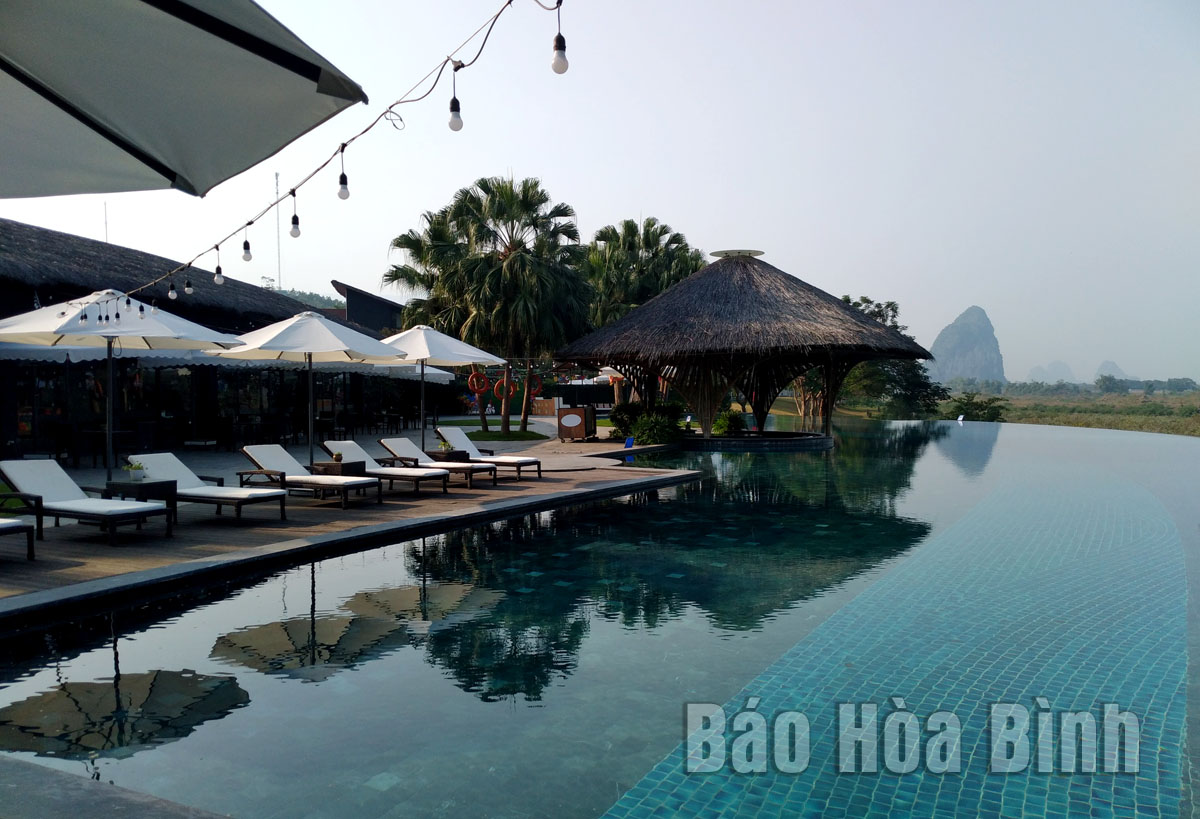
(HBO) – Kim Boi district, owning rich natural resources, especially the precious hot mineral source and various landscapes and the unique culture of Muong ethnic minority group, has great potential in promoting socio-economic growth, especially the tourism sector.
Serena Resort in Sao Bay commune of Kim Boi is an attractive destination for visitors.
For years, Kim Boi has clinched its position in the national tourism map thanks to its hot spring system. Over the years, the locality has proved its position with many high quality tourist attractions, including Serena Resort in Sao Bay commune, which covers about 30 hectares in the first phase. The four-star resort comprises high-end villas, convention halls, a restaurant, a hot mineral water swimming pool, and Japanese style onsen areas.
Besides, Kim Boi is also home to many other attractive tourism destinations such as An Lac Ecofarm, V’Resort Vinh Tien, and Cuu Thac Tu Son.
Nguyen Phuong Lan, a visitor from Hanoi who came to Kim Boi for the first time, showed her pleasure at the fresh air in the area as well as the hospitability she received. She said she will bring her family to Kim Boi at a convenient time.
In recent years, the number of tourists to Kim Boi has increased. Last year, the figure reached 450,000, including over 1,000 foreigners, who spent over 394 billion VND (16.5 million USD). In the first six months of 2023, the district welcomed 250,000 visitors, including more than 1,000 foreigners, with a revenue of 180 billion VND.
By now, Muong Dong area has attracted the interest of many investors with 25 projects, including Habi Valley Kim Boi residential-urban complex, Cuoi Ha tourist site, and Binh Son golf course. APEC Group is also building a five-star hotel and resort in Mo Da area in Bo township, while SunGroup has invested in a culture-tourism-service complex in Lac Son and Kim Boi districts.
Hoang Tuyet Mai, CEO of An Lac EcoFarm& Hot Springs, said that in order to provide a green, clean, and beautiful environment to visitors, firms have focused on preserving local landscapes to keep their natural beauty.
In the future, Kim Boi aims to become a high-end ecological and resort area. Currently, the construction of the Hoa Binh-Hanoi expressway and Son La expressway has been launched. Along with 12B Road, the project will help Kim Boi become a large-scale tourism area which takes only 1 hour driving from Hanoi.
In order to promote its potential and strengths, Kim Boi has focused on enhancing the quality of tourism services, striving to become a high-quality tourist destination of Hoa Binh. With a proper development direction, Kim Boi’s tourism sector is expected to "take off” in the time to come./.
A diverse chain of eco-tourism and resort destinations concentrated in Hoa Binh city and the districts of Tan Lac, Da Bac, and Luong Son… Along with the launch of several key high-quality resort tourism projects, these developments have reshaped the landscape and enhanced the appeal of Hoa Binh as a travel destination.
Boasting diverse terrain, a mild climate, and rich natural resources, Cao Phong district is increasingly asserting its place on Vietnam’s tourism map, attracting both domestic and foreign visitors. The district is renowned for its stunning landscapes, majestic mountains, a crystal-clear hydropower lake, and the unique cultural identity of local ethnic groups.
With its pristine landscapes, unique cultural heritage of Muong ethnic minority, and an expanding range of visitor experiences, Tan Lac district of Hoa Binh has fast become a captivating destination for both domestic and international tourists.
Until now, Sung village in Cao Son commune, Da Bac district remains the only Dao ethnic community in Hoa Binh province to develop a community-based tourism model. Beyond its untouched natural landscapes, cultural identity serves as the cornerstone attraction for visitors.
Alongside the diverse cultural identities of the Kinh, Muong, Tay, Thai, Dao, and Mong ethnic people, Hoa Binh province is also renowned as the "capital" of the northwestern Vietnamese cuisine, offering unique and distinctive dishes. At festivals, during Lunar New Year (Tet), or on significant family or community occasions, special dishes are prepared, leaving a lasting impression on visitors.
A Phong Linh (Yellow Tabebuia) flower garden in Thang village, Thach Yen commune, Cao Phong district is currently in full bloom, drawing a large number of visitors.



